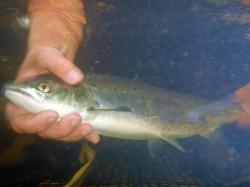Changing Environmental Conditions & Predators Affect Survival Of Gulf Of Maine Atlantic Salmon
November 29, 2011 | 3 min to read

Stocks of Atlantic salmon (Salmo salar), which have been steadily declining for the past few decades, are facing new challenges in the Gulf of Maine, where changing spring wind patterns, warming sea surface temperatures and new predators along altered migration routes are affecting their survival.
In a paper published online in the journal Fisheries Management and Ecology, Kevin Friedland and co-authors suggest post-smolts are entering an increasingly warmer coastal ocean, where they are facing mortality risks associated with a changing climate, such as changing distributions of potential predators. The authors also suggest Gulf of Maine salmon survival during their first months at sea is related to predation, possibly by populations of silver hake, red hake and spiny dogfish increasingly found along the salmon’s extended migration routes in the western Gulf of Maine. Friedland is a researcher at the Narragansett Laboratory of NOAA’s Northeast Fisheries Science Center, and is a member of the Center’s Ecosystems Assessment Program.
Gulf of Maine Atlantic salmon are listed as endangered, and returns of these fish to rivers where they spawn have been low despite increased numbers of smolts entering the marine environment. The researchers examined a variety of data collected over decades, including spring wind patterns, Gulf of Maine currents, ocean circulation systems, historical tagging returns, migratory routes, and changes in potential predator abundances and distribution patterns. Models were used to consider how shifting climate and biological factors, under various scenarios, affected salmon recruitment and survival in the Gulf of Maine.
“This study had two primary goals. The first was to examine the effects of spring winds in the Gulf of Maine on the migration trajectory of post-smolts, since the route and length of migration could impact their mortality or survival,” said Friedland. “The second goal was to look at the spatial distribution and abundance of a number of potential predators, since increased predation along the the post-smolts migratory routes could result in increased mortality.”
Atlantic salmon are anadromous fish, meaning they are born in fresh water and migrate from rivers to the ocean after undergoing a number of distinct stages of development over several years. As smolts, the thin silver fish head to the ocean, usually between March and June, to begin a stage of enhanced feeding and growth. After several years at sea, adults return to the freshwater streams and rivers where they were born to reproduce.
At one time Atlantic salmon could be found in rivers throughout much of New England, but Maine is now the only state in the region with wild Atlantic salmon populations. While increasing numbers of smolts are entering the ocean via the Gulf of Maine, few are returning, raising questions as to where these fish are going and what is happening to them at sea.
“Shifting environmental conditions affect both the freshwater and marine habitats for Atlantic salmon, and are already a concern for salmon stocks at the southern end of their distribution range in both North America and Europe, “Friedland said. “Understanding the linkages between post-smolt survival and climate, especially ocean conditions, is critical and needs to be considered in the scientific basis for conservation planning and management actions.”
Rising temperatures could exceed the tolerable limits for juvenile salmon and reduce the amount of habitat.available for growth and development during their freshwater stages.. Warming ocean temperatures in the Gulf of Maine, expected to occur in the decades ahead, could result in extirpation of salmon stocks from the southern end of the species' range.
In addition to lead author Kevin Friedland, study authors included James Manning and Jason Link from the NEFSC’s Woods Hole Laborator; James Gilbert from the University of Maine, Orono; and Andrew Gilbert and Allan O’Connell, Jr. from the U.S. Geological Survey’s Patuxent Wildlife Research Center.
# # #
NOAA Fisheries Service is dedicated to protecting and preserving our nation’s living marine resources and their habitat through scientific research, management and enforcement. NOAA Fisheries Service provides effective stewardship of these resources for the benefit of the nation, supporting coastal communities that depend upon them, and helping to provide safe and healthy seafood to consumers and recreational opportunities for the American public.
NOAA’s mission is to understand and predict changes in the Earth's environment, from the depths of the ocean to the surface of the sun, and to conserve and manage our coastal and marine resources. Join us on Facebook, Twitter and our other social media channels.
Source: NOAA Fisheries Service
